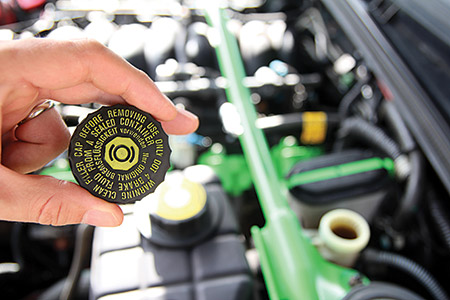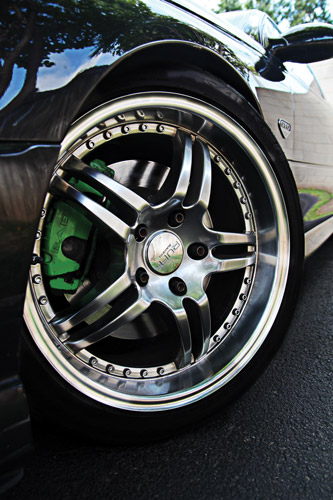What You Should Know About Brake Fluid
 Have you ever found yourself in a store isle looking at various brake fluids and wondering which one was right for your vehicle? Or maybe you just want the best performance from your braking or clutch system? Is your decision based on price or the fancy label on the bottle? There are many options and lots of information to decipher.
Have you ever found yourself in a store isle looking at various brake fluids and wondering which one was right for your vehicle? Or maybe you just want the best performance from your braking or clutch system? Is your decision based on price or the fancy label on the bottle? There are many options and lots of information to decipher.
The Importance of Brake Fluid
Brake fluids are mainly used in the braking and clutch systems of on- and off-road vehicles. Typical applications include automobiles, motorcycles and light trucks. With roughly 253 million vehicles on American roadways daily, the braking system is vital for driver safety.
While vehicle owners may change their brake pads, rotors or drums based on a mechanic’s recommendation or their car not stopping as soon as it once did, few people replace the brake fluid. Indeed, brake fluid may be a car’s most neglected component.
Reading your vehicle’s owner manual will provide details on certain time-based or mileage-based service that should be performed, including oil, transmission, coolant and differential fluid changes. However, most American manuals offer no guidelines for when to service the brake fluid. The recommendations from fluid manufacturers and other countries typically range from one to two years for performing a flush of the braking system.
Contamination
Why should you change brake fluid if your vehicle’s manufacturer doesn’t give direction for doing so? Simply put, brake fluid is no different than the other fluids in your vehicle and should be replaced. It is subjected to contamination from deteriorating hoses and lines. When the master cylinder is opened up to inspect the fluid level, it is exposed to moisture contamination. If the brakes are not properly bled, air contamination will remain in the system. The high temperatures associated with braking can also cook the oil inside the caliper or wheel cylinder. This heat combined with any of the previously mentioned contaminants can result in a poor-performing braking system.
Air
Air contamination within a braking system can occur in a variety of ways. The leading cause is poor bleeding of the system. Air may also enter the system due to worn seals and components. Over time, as the pistons move back and forth, the seals will break down, allowing air into the system. When worn or broken components are changed, pockets of air may also move into the system and be difficult to purge out.
The traditional bleeding method of having one person depress the brake pedal while another person bleeds the air at the wheel can be very time-consuming and often is not the most effective for removing 100 percent of the air. Vacuum and pressure systems offer better options for removing the air.
Moisture
By design, a brake fluid is formulated to absorb moisture. Otherwise, water molecules could rot the internal components and damage the braking system. Of course, this property comes at a price. As the brake fluid absorbs moisture, it lessens the fluid’s performance. The high temperatures common with braking systems can result in this moisture vaporizing, which causes the fluid to become compressible and gives you that “spongy” feeling.
Not all brake fluids have this property of absorbing moisture. Silicone fluids will only absorb so much moisture, leaving the rest to stay in free form and sink to low spots in the system. This can lead to corrosion.
So whether the contamination is from air, water, temperature or foreign materials, your brake fluid will need to be changed. I recently went through this with my car. While at the quarter-mile drag strip on a sunny day, I lost the functionality of my clutch. With a combination of hard launches and old fluid in my reservoir, my clutch pedal fell dead to the floor as I was trying to shift into third gear. After giving the car some time to cool down, I discovered that my clutch pedal came back to its normal firmness.
I sought a solution to this problem and found I was not the only one to experience this phenomenon. I set out to correct the issue by purchasing some components that didn’t allow the supply line to the slave cylinder to be exposed to such intense heat. Another improvement was adding a remote bleeder to the system. With my new hardware and fluid, I’m now able to change out the fluid quickly without much hassle and haven’t had a disappearing pedal since.
Classifications and Standards
Brake fluids are categorized into four main classifications by the U.S. Department of Transportation (DOT): DOT 3, DOT 4, DOT 5 and DOT 5.1. Most fluids fall into the DOT 3, DOT 4 or DOT 5.1 classification. These fluids are all hygroscopic, which means they absorb moisture from the air. DOT 5 fluids are not hygroscopic but are often used in vehicles that sit for long periods of time, such as collector cars or military vehicles.
The chemical composition of the fluids also changes with the different classifications. DOT 3 fluids are glycol ether based.DOT 4 fluids are a mixture of glycol ether with borate ester. DOT 5.1 fluids use borate ester with glycol ether blended in, while DOT 5 fluids are silicone based.
The Federal Motor Vehicle Safety Standards (FMVSS) No. 116 defines the properties that a brake fluid must have to be categorized into one of the DOT classifications. The table below shows some of the limits a fluid must meet to fit within this classification.
| Dry Boiling Point | Wet Boiling Point | Viscosity @ -40°C | Viscosity @ 100°C | Chemical Composition | |
|---|---|---|---|---|---|
| DOT 2 | 190°C/374°F | 140°C/284°F | - | - | Castor Oil/ Alcohol |
| DOT 3 | 205°C/401°F | 140°C/284°F | Max. 1,500 mm²/s | Min. 1.5 mm²/s | Glycol Ether |
| DOT 4 | 230°C/446°F | 155°C/311°F | Max. 1,800 mm²/s | Min. 1.5 mm²/s | Glycol Ether/ Borate Ester |
| DOT 4+, SUPER DOT 4 | 300°C/572°F | 180°C/356°F | Max. 750 mm²/s | Min. 1.5 mm²/s | Glycol Ether/ Borate Ester |
| DOT 5 | 260°C/500°F | 180°C/356°F | Max. 900 mm²/s | Min. 1.5 mm²/s | Silicone |
| DOT 5.1 | 260°C/500°F | 180°C/356°F | Max. 900 mm²/s | Min. 1.5 mm²/s | Borate Ester/ Glycol Ether |
| LHM+ | 249°C/480°F | 249°C/480°F | 1,000-1,200 mm²/s | 6-6.5 mm²/s | Mineral Oil |
| DOT 4+ and Super DOT 4 fluids are not governed by FMVSS No. 116. The values shown are typical of DOT 4+ and Super DOT 4 fluids on the market. Most meet or exceed DOT 5.1 specifications for boiling points. | |||||
 These properties affect how a brake fluid performs. Boiling point is one of the major indicators of how the braking or clutch system will react. During braking, wheel cylinders and brake calipers are subjected to very high temperatures due to the friction from the brake pads coming into contact with the drum or disk. During road course events and track days, it’s not uncommon to experience caliper temperatures of 400 to 500 degrees F.
These properties affect how a brake fluid performs. Boiling point is one of the major indicators of how the braking or clutch system will react. During braking, wheel cylinders and brake calipers are subjected to very high temperatures due to the friction from the brake pads coming into contact with the drum or disk. During road course events and track days, it’s not uncommon to experience caliper temperatures of 400 to 500 degrees F.
DOT 4+ and Super DOT 4 fluids are not governed by FMVSS No. 116. The values shown are typical of DOT 4+ and Super DOT 4 fluids on the market. Most meet or exceed DOT 5.1 specifications for boiling points.
Even with these higher than normal temperatures, the brake fluid still must perform. A fluid that reaches its boiling point will vaporize inside the line. This causes the fluid to become compressible and provide inadequate hydraulic transfer of the braking force.
Boiling point can be broken into two categories: dry and wet. The dry boiling point applies to the fluid straight from the container. The wet boiling point is measured based on a 3.7-percent water absorption.
Another essential property of a brake fluid is its viscosity. Fluids must meet SAE specifications at minus 40 degrees C and 100 degrees C. For the different classifications, the minimum and maximum viscosity ranges will vary.
Packaging
The packaging in which a brake fluid is shipped and stored is also important. Before purchasing, always ensure the foil cap is intact. A damaged bottle or cap will expose the fluid to moisture contamination. According to FMVSS No. 116, there are standards for packaging and labeling by which all manufacturers must abide.
Purchase only the amount of brake fluid you need, as opposed to buying a larger bottle just because it is a better deal. Any leftover fluid should be disposed of once it has been opened, since any humidity will be sucked into the fluid, degrading the performance of the braking system when you perform a top-off or refill the system.
Testing Brake Fluids
The Federal Motor Vehicle Safety Standards (FMVSS) No. 116 stipulates the requirements for motor vehicle brake fluids. To be considered for one of the DOT classifications, a brake fluid must go through the following tests:
- Equilibrium reflux boiling point (dry boiling point)
- Wet equilibrium reflux boiling point (tested with 3.7 percent water)
- Kinematic viscosities
- pH value
- Brake fluid stability (high-temperature and chemical stability)
- Corrosion
- Fluidity and appearance at low temperature
- Reserved
- Water tolerance (low temperature and at 60 degrees C)
- Compatibility (low temperature and at 60 degrees C)
- Resistance to oxidation
- Effects on cups
- Stroking properties
- Fluid color
Final Thoughts
When deciding which brake fluid to purchase, the best advice is to stick with what’s in your system. Just because a fluid falls within a certain classification doesn’t mean it won’t provide equal or better performance than a fluid with a higher classification. Depending on the composition, a DOT 3 fluid may have a better boiling point than a DOT 4 fluid. In addition, vehicles with an anti-lock braking system (ABS) are designed to work within the viscosity range of the specified classification.
Keep in mind that even though all fluids meeting DOT specifications must be compatible, mixing is not recommended. DOT 5 fluids should never be mixed with other classifications. The different boiling points and standards can result in decreased performance. A vehicle specified to use a DOT 3 fluid was designed and tested for the compatibility of the DOT 3 fluid’s chemical composition. Changing classifications will alter the chemical composition, and the compatibility of components will be unknown. Therefore, when switching fluids, a full system cleanse should be performed.
Unless you are a professional racecar driver, a change in brake fluid will likely be unnoticeable. When replacing your fluid, it’s more important to properly bleed your system and seal everything. Also, don’t use brake fluid that has been sitting around for an extended period of time. As mentioned previously, brake fluids are hygroscopic, so any humidity will end up inside the bottle. By changing your brake fluid every one to two years, you should enjoy many years of reliable braking.
